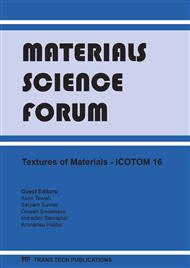p.562
p.566
p.570
p.574
p.578
p.585
p.591
p.595
p.599
Metallographic Preparation for Electron Backscattered Diffraction
Abstract:
Electron Backscatter Diffraction measurement can provide much analytical information, such as the phase orientation or material identification. The “Quality” rating of the backscatter diffraction depends on the success rate of indexing. To achieve this, a deformation-free preparation is essential. In recent years most preparation methods have been optimized to contain on average only three to four sample preparation steps. The sample quality is excellent when reflected light microscopy is used. Due to the low information depth of the EBSD measurement (20-100nm), the standard method must be modified. The preparation method must remove the scratches and the underlying damage in order to obtain a high quality EBSD pattern. The optimization can be done by chemo-mechanical polishing, electrolytic polishing or vibratory polishing. Examples are used to show where the limits of the technologies are and to give helpful ‘Hints’ for EBSD sample preparation.
Info:
Periodical:
Pages:
578-581
Citation:
Online since:
December 2011
Authors:
Price:
Сopyright:
© 2012 Trans Tech Publications Ltd. All Rights Reserved
Share:
Citation:


